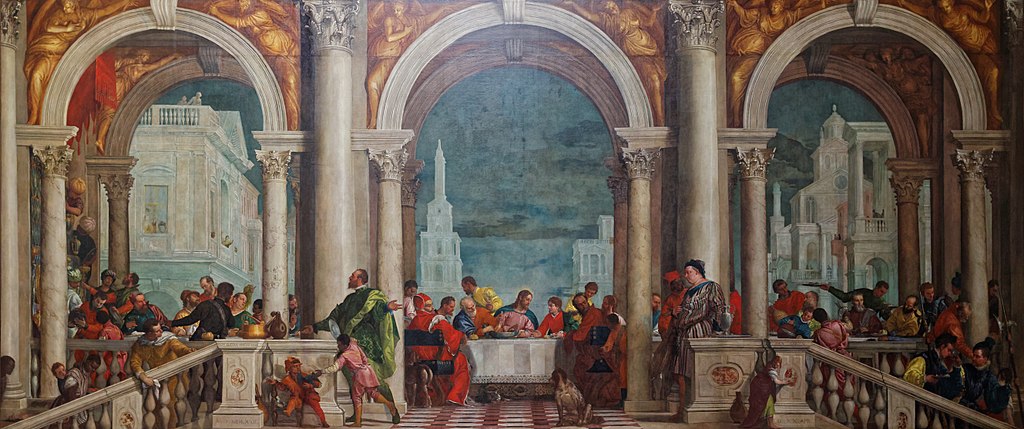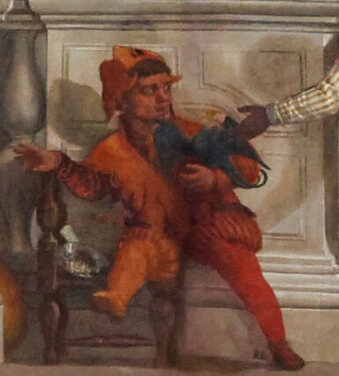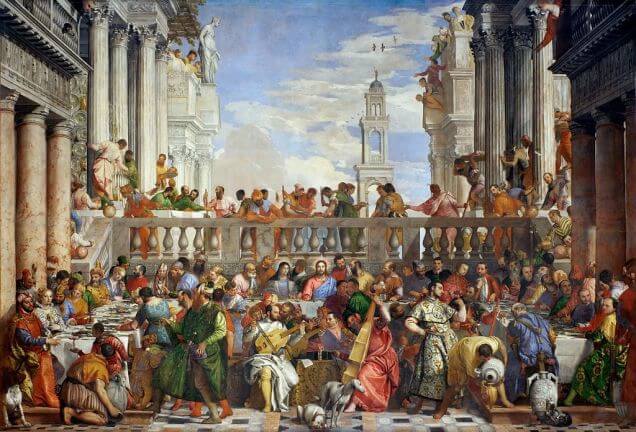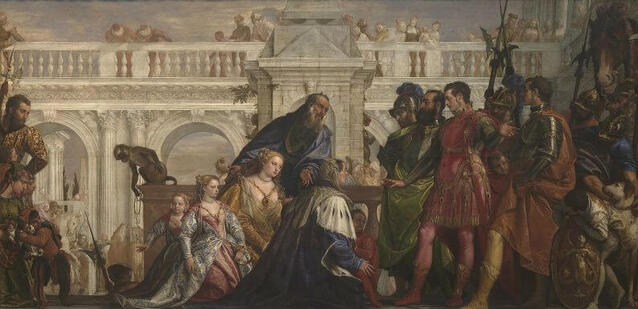|
Where? Room 10 of the Gallerie dell’Accademia
When? 1573 Commissioned by? The Dominican Friars of the Basilica di Santi Giovanni e Paolo in Venice What do you see? A depiction of the Last Supper against an impressive architectural background. The painting is divided into three areas divided by Corinthian columns and three enormous arches which are part of a loggia. The Last Supper takes place under the arch on the left and the arch in the middle. All twelve apostles and Jesus are included in this painting. In the middle of the table sits Jesus who you can recognize by the faint halo around his head. He is probably talking to Saint John. To the left of Jesus (from our point of view) is the bearded Saint Peter who is taking a piece of lamb to pass on to the left. The person on the other side of the table, across from Saint John, may be Judas who is looking away from the table. The scene shows a big feast with lots of wine, food, and interactions between the almost 50 guests. Besides the apostles, the scene includes Germans (on the far right), African servants, Turks with turbans (on the far left), and fashionably dressed Venetians. In the background is a capriccio of Venice. A capriccio is an architectural fantasy in which several buildings in Venice are placed together to create a beautiful background. In the building on the left, several people observe the feast.
Backstory: This painting is one of the larger paintings in the world and measures (18 x 42 ft or 555 by 1280 cm). Veronese originally prepared this painting under the title, The Last Supper, for the dining room of the Basilica di Santi Giovanni e Paolo in Venice. The painting replaced a painting of Titian on the Last Supper that was burned by the Germans a few years earlier.
The Last Supper is described in the Bible in all four Gospels: Matthew 26, Mark 14, Luke 22, and John 13. However, after some pressure from the Inquisition (see below), Veronese changed the title of the painting after it was finished into The Feast in the House of Levi. Mark 2:15 and Luke 5:29 describe this story. The Last Supper in Art: The Last Supper has been a popular topic in art, especially during the Renaissance. The most well-known work on this subject is probably the mural painting by Leonardo da Vinci in the Santa Maria delle Grazie church in Milan. This mural is very sober and focuses on the most important elements of the Last Supper. Da Vinci's fresco is in stark contrast to the painting by Veronese who added all sorts of ‘distracting’ elements to the scene. Another magnificent painting on this subject is The Last Supper by Tintoretto. This painting hangs in the San Giorgio Maggiore church in Venice and shows the Last Supper from a different angle.
Who is Paolo Veronese? Paola Caliari, better known as Paolo Veronese, was born in 1528 in Verona (which explains the name under which he is known nowadays), which lays about 80 miles (or 130 km) west of Venice. He died in 1588 in Venice, and many people consider him to be one of the top three painters from 16th century Venice (together with Tintoretto and Titian).
Veronese was specialized in large colorful paintings, such as the current one. Perhaps his most famous painting is The Wedding at Cana in the Louvre. Another large painting by Veronese is The Family of Darius before Alexander in the National Gallery in London.
Fun fact: In July 1573, Veronese was ordered to appear before the Inquisition in Venice to defend this painting, which carried the title, The Last Supper, at that time. They inquired Veronese why there were so many distracting elements in the painting and why only a small part focused on the Last Supper. There are many elements in this painting that are unrelated with the Last Supper, and therefore the painting would not belong in a church as it would only distract viewers from its main message.
The Inquisition asked Veronese to change various figures in the painting (for example, the dog in the foreground should be replaced by Mary Magdalene). However, Veronese declined this option and was of the opinion that the artist should have artistic freedom to create the painting in his or her own way. Instead, he decided to change the title of the painting into The Feast in the House of Levi (which you can see written in Latin in the cornice to the left of the dwarf jester). This solution satisfied the Inquisition, the commissioners, as this dinner is one of the few dinners of Jesus that is not considered sacred by the Catholic Church.
Written by Eelco Kappe
References:
0 Comments
Leave a Reply. |
Categories
All
|
- Home
- Blog
-
Museums
- Alte Pinakothek
- Art Institute of Chicago
- Baltimore Museum of Art
- Barber Institute of Fine Arts
- Bargello
- Barnes Foundation
- British Museum
- Church of Sant’Anastasia
- Cleveland Museum of Art
- Courtauld Institute of Art
- Detroit Institute of Arts
- Frans Hals Museum
- Galleria Borghese
- Gallerie dell'Accademia
- Getty Museum
- Guggenheim
- Hermitage Museum
- Kunsthistorisches Museum
- Kunstmuseum Basel
- Legion of Honor Museum
- Louvre
- Mauritshuis
- Metropolitan Museum of Art
- Musee d’Orsay
- Museum of Fine Arts in Boston
- Museum of Modern Art
- National Gallery in London
- National Gallery of Art
- National Museum in Poznań
- Norton Simon Museum
- Ny Carlsberg Glyptotek
- Palace of Versailles
- Palazzo Pitti
- Palazzo Vecchio
- Petit Palais
- Philadelphia Museum of Art
- Prado
- Pushkin Museum
- Ravenna Art Museum
- Rijksmuseum
- San Diego Museum of Art
- Santa Maria delle Grazie
- St. Peter's Basilica
- Städel Museum
- Statens Museum for Kunst
- Tate Britain
- Tate Modern
- Timken Museum of Art
- Uffizi
- Vatican Museums
- Wallace Collection
-
Artists
- Altdorfer
- Anguissola
- Berlin Painter
- Bosch
- Botticelli
- Boucher
- Bronzino
- Bruegel the Elder
- Brunelleschi
- Cabanel
- Caillebotte
- Canova
- Caravaggio
- Carpeaux
- Cezanne
- Cimabue
- David
- Degas
- Delacroix
- De Maria
- Donatello
- El Greco
- Fontana
- Fra Angelico
- Fragonard
- Gauguin
- Gentileschi
- Gericault
- Gonzalez-Torres
- Goya
- Hals
- Hogarth
- Hokusai
- Ingres
- Leonardo da Vinci
- Lippi, Filippo
- Longhi, Barbara
- Lorrain
- Makovsky
- Manet
- Massys
- Matisse
- Merian
- Michelangelo
- Mochi
- Modigliani
- Monet
- Panini
- Parmigianino
- Perugino
- Picasso
- Pisanello
- Raphael
- Rembrandt
- Renoir
- Reynolds
- Rivera
- Rodin
- Rubens
- Scultori
- Seurat
- Steen
- Tintoretto
- Titian
- Toulouse-Lautrec
- Turner
- Uccello
- Van der Weyden
- Van Dyck
- Van Eyck
- Van Gogh
- Van Hemessen
- Vasari
- Velazquez
- Vermeer
- Veronese
- Vigée Le Brun
-
Locations
- Books
- About Us






